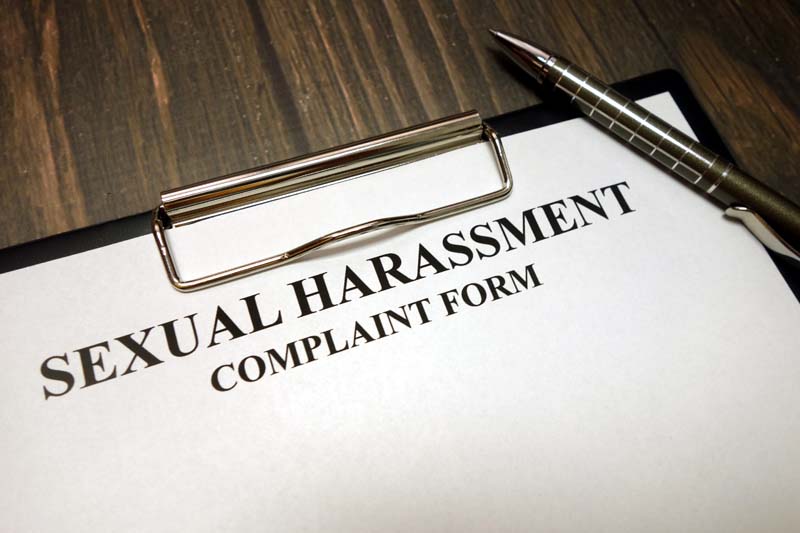Sexual harassment reforms and the legal profession

New protections against sexual harassment are now available to people working in the law, including those at the New South Wales Bar.
The Sex Discrimination Act 1984 (Cth) (SDA) has recently been amended to implement a range of recommendations from the Respect@Work report that the Sex Discrimination Commissioner, Kate Jenkins, provided to the Federal Government last year.
The prevalence of sexual harassment in the legal profession is well known. A global survey by the International Bar Association in 2018 found that 47% of women and 13% of men working in law in Australia had experienced workplace sexual harassment, significantly higher than the global average. The Respect@Work report identified a number of steps that need to be taken to address this problem, and these include making legal protections simpler and remedies more accessible.
The way that the SDA operates is to prohibit sexual discrimination and harassment in various areas of public life. One of those areas is employment but, prior to the recent amendments, the SDA reflected an outdated understanding of working relationships. It also had significant gaps which meant that self-employed practitioners, like barristers, had fewer protections.
Since 11 September 2021, the areas in which sexual harassment is prohibited have expanded significantly. One aim of the amendments was to ensure coverage for all workers and all workplaces.
Some of the amendments clarify the existing scope of the SDA. For example, Justices of the High Court, Federal and State judges and magistrates and their staff are now explicitly covered by the prohibitions against sexual harassment in the workplace.
For the first time, it is clear that unpaid workplace participants, including volunteers and unpaid interns, can make a complaint about sexual harassment that occurs while they are at work. This is because they fall under the new definition of ‘worker’, taken from the Work Health and Safety Act 2011 (Cth) (WHS Act). It doesn’t matter whether the harassment is by a boss, a co-worker or a client. If the harassment occurs in connection with the person being a ‘worker’ then it is prohibited.
Similarly, barristers will be able to make complaints under the SDA if they are sexually harassed at work. This is because the Act now prohibits the harassment of (or by) a ‘person conducting a business or undertaking’ if the harassment occurs in connection with the person having that status. Again, this new definition aligns with the WHS Act.
Previously, barristers had to rely on the prohibition under the SDA against sexual harassment in the course of seeking, providing or receiving legal services. However, this was a much narrower protection, for example, barristers do not ordinarily provide each other with legal services. Alternatively, barristers had to choose to make a complaint to the Legal Services Commissioner about another barrister allegedly in breach of Rule 123(a) or (b) of the Legal Profession Uniform Conduct (Barristers) Rules 2015.
Now, barristers have a broader protection under the SDA that applies while they are undertaking any activities in connection with their work.
In practice, this means that a barrister can make a complaint about sexual harassment by another barrister (as both barristers are ‘persons conducting a business or undertaking’ for the purposes of section 28B(5) or (6) of the SDA), a client (in the case of a direct brief), an instructing solicitor, or by someone that they share a floor with (for instance, another barrister on the floor, or an employee or contractor either of the barrister or of the floor itself). This could be conduct that occurs in chambers, in and around court precincts, at a work or professional development function, in a vehicle travelling to a client’s premises, or even as part of a work-related conversation that started in chambers and was continued at the pub. It also means that barristers are liable for sexual harassment that occurs while they are at work, for example, conduct by a barrister directed at another barrister or a junior (or senior) solicitor on the other side of a matter (or on their own side), or even conduct directed to a member of the public sitting in the public gallery of a courtroom.
The amendments streamline the coverage of the SDA to prohibit sexual harassment generally in the ‘world of work’. This will have particular relevance for new forms of work in the gig economy where traditional employment relationships don’t apply. But it also ensures greater protections in areas like law where for too long coverage of existing working relationships has been unclear or insufficient.
There are a number of other recommendations for legislative reform that are currently under consideration by Federal, State and Territory governments, including introducing a positive duty on employers to prevent sexual harassment under the SDA, prohibiting sexual harassment under the Fair Work Act 2009 (Cth), introducing protections for alleged victims of sexual harassment who are witnesses in civil proceedings and developing a practice note, guideline or regulation on the use of non-disclosure agreements in workplace sexual harassment matters.
Significant activity is underway to implement the recommendations from the Respect@Work report in line with the Federal Government’s response – A Roadmap for Respect – released on 8 April 2021. The Respect@Work Council is Chaired by the Sex Discrimination Commissioner and has oversight responsibility for many recommendations. Information about the Council’s work can be viewed at https://www.ag.gov.au/rights-and-protections/human-rights-and-anti-discrimination/respect-at-work/council.

Equality Across the Board: guidance on sexual harassment prevention for ASX200 companies
By Kate JenkinsOn 17 June 2021 the Australian Human Rights Commission (AHRC), in partnership with the Australian Council of Superannuation Investors (ACSI), released a report offering guidance to corporate boards and investors on preventing and responding to workplace sexual harassment.
The recommendations in the report are aimed at being of great assistance to corporate clients. Moreover, while the report is directed at corporations, other organisations such as barristers’ chambers might find that some of the recommendations are relevant to their circumstances.
Our report, Equality Across the Board: Investing in workplaces that work for everyone, was based on a comprehensive survey of 118 ASX200 companies, as well as in-depth interviews I conducted with representatives of 16 ASX200 companies.
The report was commissioned by ACSI following the release of the AHRC’s 2020 National Inquiry into workplace sexual harassment, Respect@Work, which found that one in three people had experienced sexual harassment at work in the previous five years.
Respect@Work found that workplace sexual harassment causes immense social and economic harm, with the annual cost to the Australian economy estimated to be $3.8 billion in 2018.
Equality Across the Board provides a detailed overview of how Australian companies currently respond to workplace sexual harassment and provides insight into how Australian companies collect and use data relating to sexual harassment, and how that information is reported internally and externally.
In addition to making recommendations for corporate boards and executive leadership, the report provides advice for investors on how they can manage financial risks associated with workplace sexual harassment within investee companies.
More than half (118, or 59%) of ASX200 companies participated in the research survey. Our research also drew from desktop research of existing legislative and regulatory frameworks.
Clearly, collection of information alone is not enough to prevent and address sexual harassment. The report finds a range of progression across ASX200 companies when it comes to using data to manage material risk. Information must be analysed, shared and acted upon for it to be useful. If information is not appropriately escalated within an organisation, risk cannot be effectively and proactively managed by those responsible.
Recommendations
Equality Across the Board recommends that boards focus on oversight of prevention of, as well as response to, sexual harassment. Boards should take primary responsibility and accountability for ensuring the company has in place a governance framework for sexual harassment, and for monitoring performance against this framework across the organisation. A board should also clearly identify the information it expects to receive in monitoring performance, including information to assess how effective the organisation’s systems are in preventing, as well as responding to, sexual harassment.
More specifically, the report makes six recommendations for boards and executive leaders, including that boards demonstrate visible leadership and governance over workplace culture, sexual harassment and gender equality; that directors and executive management have the skills and experience to effectively prevent and respond to sexual harassment; that boards make gender equality a strategic priority backed by gender diversity targets; boards ensure that robust systems and frameworks are in place to monitor the collection, use and reporting of sexual harassment data; boards align the appointment, expertise and knowledge management of the executive leadership team with organisational values; and that boards report internally and externally to monitor the effectiveness of systems and frameworks that are in place to address sexual harassment.
It also makes two recommendations for investors, including that investors seek information about the frameworks in place to prevent and respond to sexual harassment within a company, and that investors advocate for improved transparency and public disclosure on sexual harassment.
I welcome ACSI’s initiative in commissioning this survey and report, and their recognition of the critical role that ASX200 boards and executive management have in preventing and responding to workplace sexual harassment.
The recommendations within Equality Across the Board offer a blueprint for Australia’s largest corporations to reduce the prevalence of sexual harassment in their workplaces and build safer, more equal workplaces for all.
The prevalence of sexual harassment in the legal profession is well known. A global survey by the International Bar Association in 2018 found that 47% of women and 13% of men working in law in Australia had experienced workplace sexual harassment, significantly higher than the global average. The Respect@Work report identified a number of steps that need to be taken to address this problem, and these include making legal protections simpler and remedies more accessible.

Update on the launch of the OLSC online anonymous sexual harassment, bullying and discrimination reporting platform
Announcement by the Office of the Legal Services CommissionerIn the Autumn 2021 edition of Bar News, the New South Wales Legal Services Commissioner, John McKenzie, announced that the Office of the Legal Services Commissioner would soon launch an online anonymous reporting tool to receive notifications of sexual harassment, bullying and discrimination in the legal profession. This exciting development is forecast to be operational later in 2021 or early in 2022.
In addition, since 2019 the OLSC has had facilities to receive anonymous reports of sexual harassment, bullying and discrimination alleged against barristers and solicitors, with those reports able to be made by telephone, email or post, including via downloadable anonymous notification forms on the OLSC website.
In the Autumn 2021 edition of Bar News, John McKenzie said that, since the introduction in 2019 of the facilities to receive anonymous reports, the reports received by the OLSC of sexual harassment, bullying and discrimination had risen then from 3-4 per year to between about 140 to 150 per year.
Significantly, now the reports or enquiries of sexual harassment, bullying or discrimination have risen to approximately 250 per year.
Where formal complaints are received and determinations are made that disciplinary action is to be taken as a result of a finding of breach of rule 123 of the Legal Profession Uniform Conduct (Barristers) Rules 2015, this is recorded on the OLSC’s Register of Disciplinary Action, which is publicly available on the OLSC website. A number of formal complaints are currently before the OLSC.
Upon its launch, the new OLSC online anonymous reporting platform will be downloadable via smartphone and other smart devices. Where clusters or ‘hotspots’ of such alleged conduct are identified in chambers or law firms, or where it is identified that such conduct may be condoned, the Legal Services Commissioner carries out investigations.
Significantly, now the reports or enquiries of sexual harassment, bullying or discrimination have risen to approximately 250 per year.